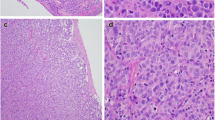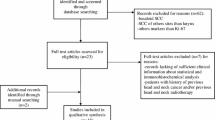Abstract
The difficult and complicated mechanism of cancer development with little knowledge about the biology of existing cancers can lead to a permanent search for new examination techniques to improve the precision of life expectancy in patients and the selection of the most efficient methods of treatment. The aim of this study was to analyze certain prognostic factors, i.e., p53, Ki67, proliferating cell nuclear antigen (PCNA), DNA ploidy and cell proliferating activity, as well as the degree of morphological differentiation and cell maturity evaluated on an ultrastructural level in patients with laryngeal cancers in connection with data obtained from follow-up examinations and the clinical course of the disease. Neoplastic tissue was taken from 120 patients with laryngeal cancers. All underwent surgical treatment, radiotherapy and combined treatment in the Department of Otolaryngology, Karol Marcinkowski University School of Medical Sciences, Poznań, Poland, and the Department of Otolaryngology – Head and Neck Surgery, Haukeland University, Bergen, Norway. Before beginning treatment all patients underwent histological verification of their neoplastic tissues. Histopathological examination proved that the majority of cases (95%) had a squamous cell carcinoma. The occurrence of changes within the lymph nodes of the neck (N) was significantly correlated with T, S, Ki67, metastases to lymph nodes, DNA ploidy, site and surgery performed. The degree of clinical progression (S) was intercorrelated with T, N, p53, Ki67, PCNA, DNA ploidy, site and laryngectomy. The occurrence of oncoprotein p53 in neoplastic cells was measured by the staining degree of their nuclei and was correlated with T, S, DNA ploidy, metastases to lymph nodes, PCNA and site. The degree of staining of neoplastic cells for the nuclear antigen Ki67 was correlated to T, N, G, S, DNA ploidy, metastases to lymph nodes and surgical treatment. The proliferative antigen PCNA in the examined population of patients was intercorrelated with T, p53, Ki67, metastases to lymph nodes and surgical treatment. The results obtained from DNA flow cytometry could be associated with N, G, p53, Ki67 and metastases to lymph nodes. On the basis of the results obtained, the techniques suggested for the morphological and biological evaluation of neoplastic cells in cancer of the larynx should include TNM classification + G + DNA + p53 + Ki67.
Similar content being viewed by others
Author information
Authors and Affiliations
Additional information
Received: 26 September 1998 / Accepted: 13 April 1999
Rights and permissions
About this article
Cite this article
Golusinski, W., Olofsson, J., Szmeja, Z. et al. A comprehensive analysis of selected diagnostic methods with respect to their usefulness in evaluating the biology of neoplastic cells in patients with laryngeal cancer. European Archives of Oto-Rhino-Laryngology 256, 306–311 (1999). https://doi.org/10.1007/s004050050252
Issue Date:
DOI: https://doi.org/10.1007/s004050050252




